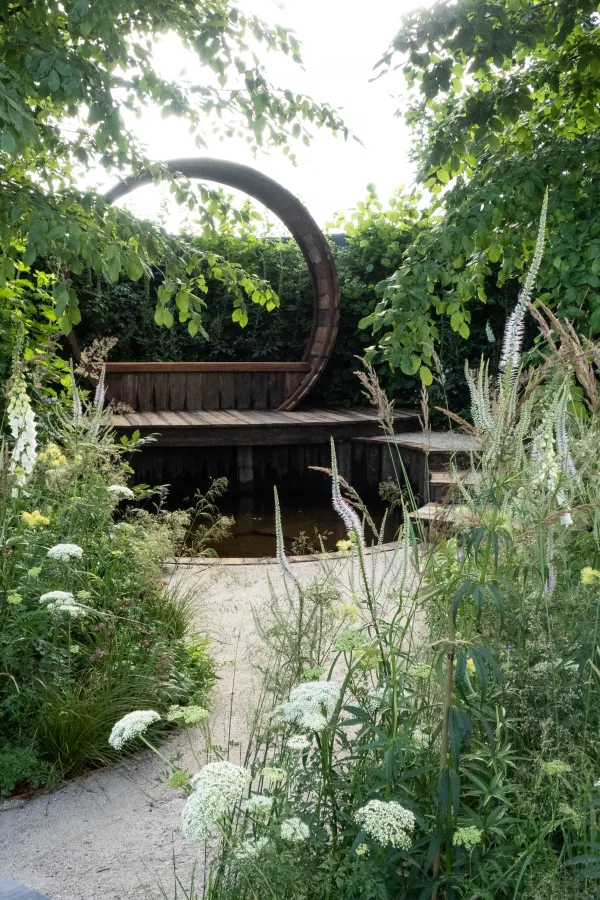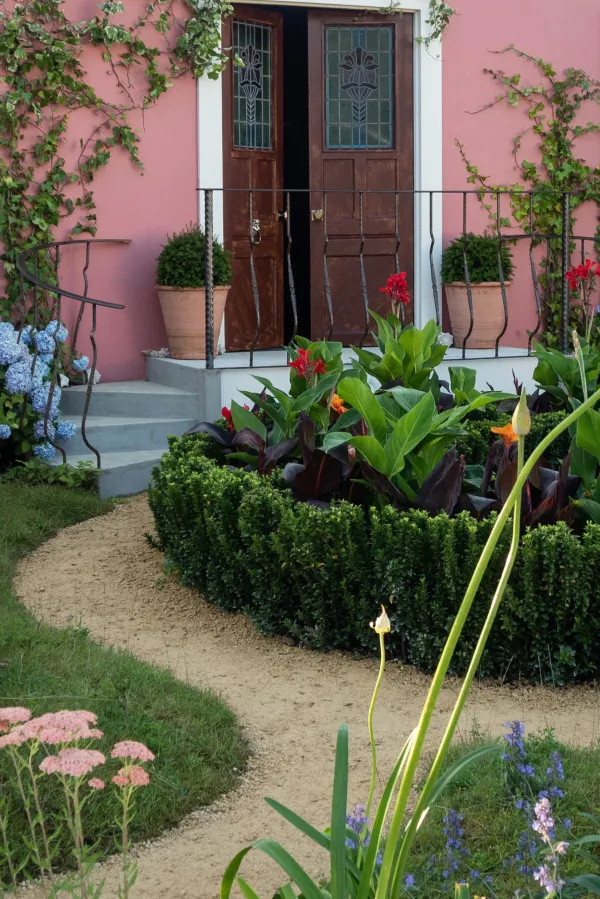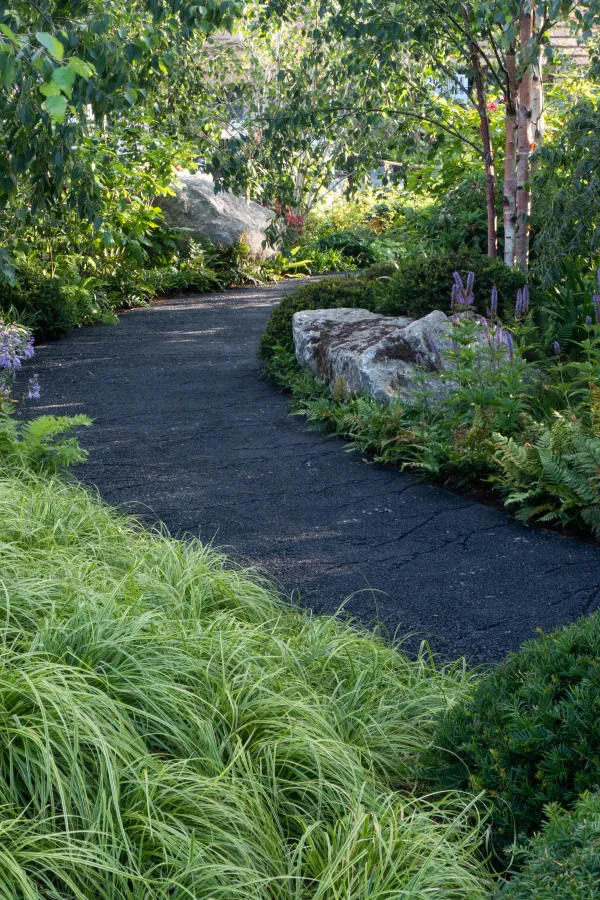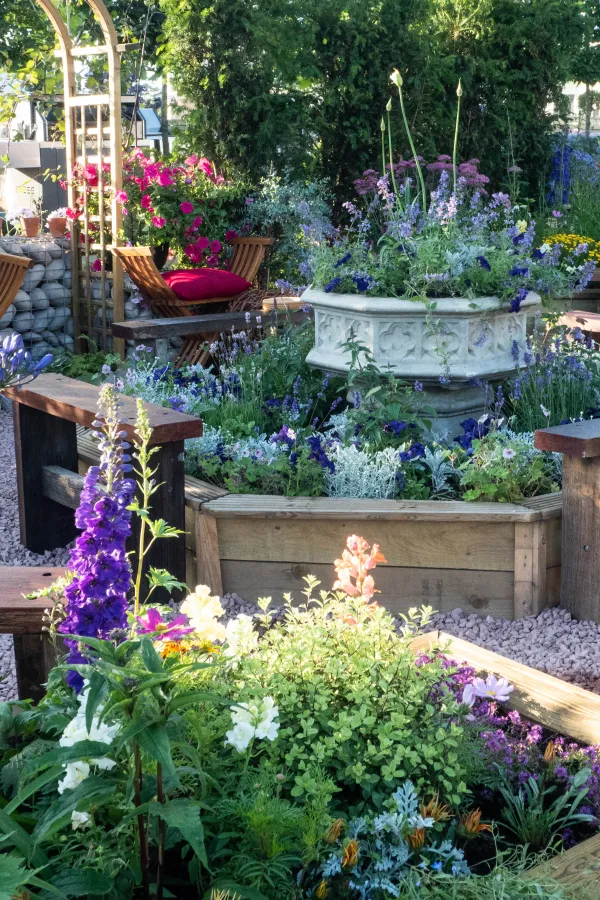Curved gardens are back in a big way. That was my conclusion after going round the show gardens at the RHS Hampton Court Garden Festival.
The Cancer Research Garden, designed by Tom Simpson, turns a rectangular space into an entirely curved one. It has a winding path, circling round, then down to a circular seating area and a round pond.
For the last decade or so, garden design has been largely angular, especially in smaller gardens. Straight lines work well in urban gardens. They look smart. And they’re a good way of organising space.
But today’s trend towards naturalistic planting seems also to have triggered a fresh interest in what curves can do for your garden.
And interior trends often influence garden design, too. Curvy sofas, tables and curved layouts are big news in contemporary homes. As garden designer Pollyanna Wilkinson says when talking about the basics of garden design, it’s a good idea to take elements from your home and repeat them in the garden. That could be choosing a similar floor colour in your kitchen pavers and your outdoor patio. Or it could be echoing the curves in your furniture or room design.
The advantages of curves in gardens
The main problem in most small gardens is that you can usually see the whole garden at once. As soon as you add curves, then there is a sense of adventure. Where does that path go? What is hidden behind that bend?
It can make the garden feel bigger. And it can also make it feel more private, if the curves wrap themselves round where you sit or eat.

The Stop and Pause Garden, designed by Dave Green, uses a curving design to create a sanctuary. Plants and trees grow all round the central pond and bench.
Another garden design principle is that you can soften the hard edges of a square or rectangular garden by introducing curves in the design.
It’s worth thinking about this, although it’s also a good idea to consider the opposite. You can also echo the straight lines of a square garden in the design.
Both are good strategies. The important thing is to think about which will be right for you and the way you live in your garden.
The curved garden path…
A winding garden path always looks charming. It means you don’t see the whole garden at first glance, even if your garden is tiny.

The curving garden paths create the shape of this garden. It’s the ‘Dreams of the Indianos’ garden, designed by Rose McMonigall and sponsored by the Spanish tourist board. The ‘Indianos’ were the poor Spanish who emigrated to the New World in search of a better life, and returned when they had made their fortune. This was the garden they would have dreamed of creating.
But beware! Humans and dogs both cross spaces in straight lines. So if you create a pretty curvy path through your garden, the lawn will soon be worn down by the path everyone actually takes to cross it.
Unless, of course, you add some curved garden borders, so that people can’t just walk across.
Curving garden borders
The advantage of curved garden borders is that nature rarely grows in a straight line. Perhaps the return of the curved border is a result of the current trend towards naturalistic planting.
The top garden is the Cancer Research Garden. The other is the Naturecraft Garden, designed by Polly Wilkinson. Both gardens use hard landscaping to keep curved borders in a good shape.
But, once again, you can argue this both ways. You can echo nature with a curving garden border. Or you can contrast the straight lines of the built environment with relaxed, naturalistic planting. I think both look good.
It can be a little harder to keep a curved border in the right shape. If you just dig a curved border into a lawn, then it can easily sprawl. Or so we found when we had curved borders.
However, most of the show gardens at the RHS Hampton Court defined their borders with hard landscaping.

This curving path in the Smart Meter garden is planted on either side, but the hard landscaping means the borders are unlikely to encroach.
The return of the ‘island bed’?
Some garden lovers don’t like island beds. If you don’t know what they are, they are garden borders in the middle of the garden. The case against them is that they are, indeed, islands. Sometimes they don’t feel connected to the rest of the garden. An island bed can look as if it had been accidentally dropped by a passing aeroplane.
The plus side of an island bed is that the planting can be enjoyed from all sides. At RHS Hampton Court the show gardens connected island beds to the mainland garden with paths.

Technically this central bed is octagonal, but I think it counts as circular. This is the Therapeutic Garden, designed by Tony Wagstaff. The beds are raised to make them accessible to everyone. Although this is octagonal, the original design shown in the RHS handbook depicts the garden as having round raised beds. Perhaps round is more difficult for raised beds and octagonal gives the same impression but is easier to construct?
And curved pergolas, arches and arbours…
There were several curved arches, arbours, pergolas and moon gates in the show gardens.
The Thames Water Flourishing Future Garden, designed by Tony Woods, featured a round topped pergola.
Curved garden furniture…
I liked the idea that you can add curves to your garden by adding a curved bench or round chairs and tables.

Leave a Reply